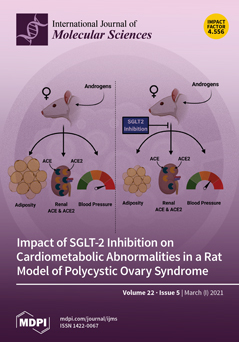The
SCN5A gene encodes the α-subunit of the voltage-gated cardiac sodium channel (Na
V1.5), a key player in cardiac action potential depolarization. Genetic variants in protein-coding regions of the human
SCN5A have been largely associated with inherited cardiac arrhythmias. Increasing evidence also
[...] Read more.
The
SCN5A gene encodes the α-subunit of the voltage-gated cardiac sodium channel (Na
V1.5), a key player in cardiac action potential depolarization. Genetic variants in protein-coding regions of the human
SCN5A have been largely associated with inherited cardiac arrhythmias. Increasing evidence also suggests that aberrant expression of the
SCN5A gene could increase susceptibility to arrhythmogenic diseases, but the mechanisms governing
SCN5A expression are not yet well understood. To gain insights into the molecular basis of
SCN5A gene regulation, we used rat gastrocnemius muscle four days following denervation, a process well known to stimulate
Scn5a expression. Our results show that denervation of rat skeletal muscle induces the expression of the adult cardiac
Scn5a isoform. RNA-seq experiments reveal that denervation leads to significant changes in the transcriptome, with
Scn5a amongst the fifty top upregulated genes. Consistent with this increase in expression, ChIP-qPCR assays show enrichment of H3K27ac and H3K4me3 and binding of the transcription factor Gata4 near the
Scn5a promoter region. Also, Gata4 mRNA levels are significantly induced upon denervation. Genome-wide analysis of H3K27ac by ChIP-seq suggest that a super enhancer recently described to regulate
Scn5a in cardiac tissue is activated in response to denervation. Altogether, our experiments reveal that similar mechanisms regulate the expression of
Scn5a in denervated muscle and cardiac tissue, suggesting a conserved pathway for
SCN5A expression among striated muscles.
Full article






